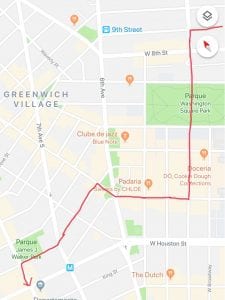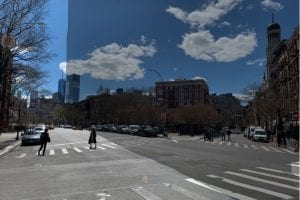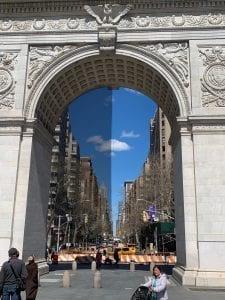- Our final vocabulary word for this semester is urban resiliency. How would you define this term for a friend? What is an example they would understand? How important is the concept of resiliency to you as an artist/designer? How might it help you creatively live and work in relation to the realities of climate change? Do you have any questions about our semester vocabulary?It’s the ability of individuals or communities in an urban scenario to adapt, and face challenges, change and implications. A common example you’d be when someone hurts themselves in the street by accident and different people gather to help the victim. I think my artwork should be resilient in a way that it can adapt to different scenarios, situations and implications, this idea sound abstract but is the only way I see the concept of resilience being important to me as an artist. Having a lifestyle in relation to the realities of climate change is very important, it would bring me awareness and I think I’d feel better to know I’m doing my part. I don’t have any questions
- Complete your Zone Walk project. Upload your map, images and responses to the questions to your LP.

-
1) Does an awareness of evacuation zones change the way you experience the city?
Yes, it definitely makes me few a little more safe and aware.
2) What areas appear to be vulnerable to storm surge, if any?
I feel like big open areas like Washington Sq Park fro example.
3) Which zone do you live in?
I’m not located in an evacuation zone.
4) Do you feel prepared for a hurricane in NYC? What would make you feel more prepared? –
I feel like I am prepared to help myself but I wish I could know more about helping people in need.
5) Do any buildings/infrastructures look more prepared for the next storm — how?
I feel like spacious buildings with stronger infrastructure look more prepared, like the NYU Law building.
6) Are any effects of Hurricane Sandy visible?
No, I don’t think so.
5- Choose one zone (1-6) as your focus. What is a design idea you have that could communicate to the public what zone they inhabit? What kind of tool, device or signage would you make? Include a list of 3-5 challenges you would face in implementing this project in NYC (think about resiliency of materials, language issues, access to information, visibility during different times of day/during storms, diversity of publics etc.).
I would probably choose zone 1 cause that is the zone in biggest risk. I’ve always wanted to build a monument. I would do a big sculpture in metal, probably corten steel to be more precise, in order to follow the esthetic lineage of my work, the form would have something to deal with natural disasters, or even the way humans are treating nature. And I thought about having a sign or communicating the following message to the public, with the sculpture: this piece would survive a storm, and you can too, know your evacuation zone (link to the nyc.gov/hurricane website). I think I would have a lot challenges to face if I actually decided to do this piece, being some of them: getting the materials, which are big, heavy and expensive. Getting an authorization from the government to put up a monument in a public space, which might be really hard and bureaucratic. And as the piece is supposed to survive different environment stages, including a possible storm, I’d have to find a way to make the material even more resilient, and not only that but I’d have to find a way to attach it to the ground in a way that’s strong, stable and safe.
_____________________________________________________________________________________
- Develop three final project ideas.
I’m moving to a new apartment in a week and I have no furniture or decorations for it yet, so I figured out I could use this project to make some pieces that would be useful to me when I move.
1- A painting using only natural/eco friendly materials (paper, pigment, and recycled wood for the frame)
2- A stool/nightstand/storage box made out of recycled wood
3- Tapestry made with eco-friendly materials (fabric and pigment)
1) What is your idea and in what ways will this object/design be useful to you over 50 years of change? Think about how each design could have meaning and be useful in your daily life for several decades.
1- The painting is for decorative purposes and the materials and be recycled and reused, such as the wood frame and the paper.
2- This would be a multi-function object, in s small size and a minimal shape so it fits different spaces and styles.
3- This is also a decorative piece, I was inspired by the natural dye project, I’d use a simple design and a plain color palette so it can also adapt to different spaces and styles in the future.
2) How will this design be resilient (used in more than one way, transform into something else over time, and/or encourage social resiliency through its usage)?
1- I believe this design can be used in different ways, but always with the same intention, decoration, and the way it could be transformed into something else is by recycling it.
2- This design would be multi-functional and could be used in different forms to meet different needs. As storage, as a nightstand, or as a stool, or even just as a decoration object. I think this could encourage social resiliency by the way it can adapt to meet different needs.
3- As decoration this design could also be used in different ways. And it could be easily turned into something else, since it would be just a painted piece of fabric, almost a raw material.
3) What specific event(s) of environmental change will it help YOU adapt to or address?
The 3 objects would be reused and done with recycled materials, and that’s because I want to avoid producing more trash and I don’t want to use artificial materials that are hard to recycle or have strong chemistries that aren’t good for the environment. The event of environmental change I think these designs could help me address would be global warming.
4) How will this design be repaired?
1- If the frame breaks I can easily put it back together using a hammer and a few nails.
2- As this is made our of wood it could also be repaired with hammer and nails.
3- This one is a large piece of fabric that can be sewed back together if it rips.
5) What materials will you use for this design given what you have learned this semester about natural/biological/recycled materials? Consider how climate change might affect the availability of some materials in the long-term.
1- Painting: natural/eco friendly materials (recycled paper, natural pigments, and recycled wood for the frame)
2- Stool/nightstand/storage box: recycled wood
3- Tapestry: Natural fabric and natural pigments
6) Which of the Long Life Design criteria does this design fulfill?
I think all of the three designs fulfill most of the criteria, being them: Repair, Cost, Manufacturing, Function, Safety, Planned production, User, Environment, Design.
 __________________________________________________________
__________________________________________________________


